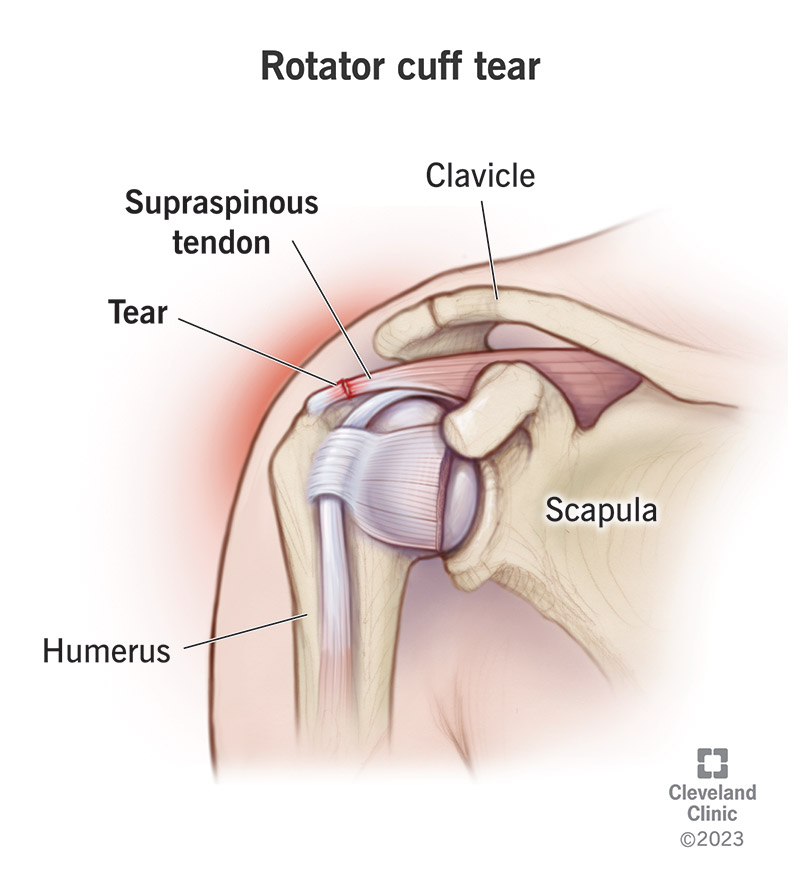A nurse in a provider's office is assessing a client who reports shoulder pain. Which of the following findings by the nurse indicates a rotator cuff injury?
Inability to abduct the arm at the shoulder.
Negative drop arm test.
Alteration in the contour of the joint.
A positive Tinel's sign.
The Correct Answer is A
Choice A reason:
The inability to abduct the arm at the shoulder is a classic sign of a rotator cuff injury. The rotator cuff is responsible for stabilizing the shoulder joint and aiding in various movements, including abduction. When there is a tear or significant weakness in the rotator cuff muscles, especially the supraspinatus muscle, the patient may be unable to lift the arm away from the body or may experience pain while doing so.
Choice B reason:
A negative drop arm test would actually indicate that there is no rotator cuff injury. The drop arm test is performed by asking the patient to fully abduct the arm to 90 degrees and then slowly lower it. If the patient can control the motion and lower the arm smoothly, the test is negative. A positive drop arm test, where the patient cannot control the descent of the arm, would suggest a rotator cuff tear.
Choice C reason:
While an alteration in the contour of the joint may indicate some form of shoulder pathology, it is not specific to a rotator cuff injury. Changes in the contour could be due to various conditions, including dislocation, arthritis, or other musculoskeletal disorders.
Choice D reason:
A positive Tinel's sign is used to diagnose nerve compression or nerve damage, not rotator cuff injuries. It is performed by tapping over the course of a nerve to elicit a tingling sensation or pain in the distribution of the nerve. This sign is commonly associated with conditions like carpal tunnel syndrome.

Nursing Test Bank
Naxlex Comprehensive Predictor Exams
Related Questions
Correct Answer is D
Explanation
Choice A reason:
Activities that could result in bleeding should be minimized for a client with neutropenia due to the increased risk of infection from open wounds. However, this is not the primary restriction related to neutropenia itself but rather a general precaution for patients with low platelet counts or other clotting issues.
Choice B reason:
Restricting all visitors from entering the client's room is not necessary unless the visitors are sick or have been exposed to infectious diseases. Neutropenic patients are at increased risk for infection, so visitors should be screened for illness, but complete isolation is not required.
Choice C reason:
Modifying oral fluid intake to between meals only is not a standard restriction for neutropenic patients. Adequate hydration is essential, and there are no specific neutropenia-related reasons to restrict fluids to between meals.
Choice D reason:
Fresh flowers and potted plants should be avoided in the room of a neutropenic patient. They can harbor fungi and other microorganisms that could cause infection in an immunocompromised individual. Neutropenic precautions typically include avoiding standing water and plants that may contain harmful bacteria or fungi.
Correct Answer is A
Explanation
Choice A reason:
The inability to move toes can be an early sign that a cast is too tight. This symptom may indicate that the cast is impinging on nerves or blood vessels, leading to decreased motor function. It is essential to address this immediately to prevent further complications such as permanent damage or compartment syndrome.
Choice B reason:
Edema, or swelling of the toes, can occur if a cast is too tight, but it may not be the first sign observed. Swelling is a response to increased pressure in the tissues and can develop over time as fluid accumulates. While it is a concern, it often follows other symptoms such as changes in sensation or movement.
Choice C reason:
Pallor of the toes, indicating reduced blood flow, can be a sign of a cast that is too tight. However, pallor may not be as immediately noticeable as the inability to move toes or changes in sensation. It is still a critical sign that requires prompt evaluation and possible adjustment of the cast.
Choice D reason:
A change in the temperature of the toes, such as them becoming cooler to the touch, can suggest impaired blood flow due to a tight cast. This sign, along with pallor, may develop after other symptoms such as numbness or motor impairment.
Whether you are a student looking to ace your exams or a practicing nurse seeking to enhance your expertise , our nursing education contents will empower you with the confidence and competence to make a difference in the lives of patients and become a respected leader in the healthcare field.
Visit Naxlex, invest in your future and unlock endless possibilities with our unparalleled nursing education contents today
Report Wrong Answer on the Current Question
Do you disagree with the answer? If yes, what is your expected answer? Explain.
Kindly be descriptive with the issue you are facing.
